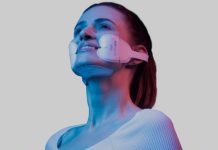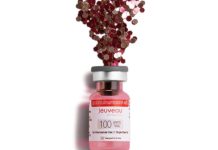Is it possible to turn back time? Alas not, and until now, there’s been no proven way of addressing the most intractable signs of aging—sagging around the jawline, loss of cheekbone definition, and, of particular concern to me, mouth folds and pronounced pouf-iness under the eyes—unless you were committed to an ongoing regimen of masking lost definition with fillers, or prepared to go all-in on a facelift. Voluntary surgery? No thanks, in my opinion: I’d rather go to the gym than get lipo, for a host of reasons, and I’ve often wondered why the geniuses developing biotechnology haven’t come up with a workout for the face, given that the root cause of the appearance of aging is the gradual slackening of muscles under the skin; as the muscles lengthen, they no longer support the facial structure and tissue begins to droop.
Now, at last, the geniuses have come through: What’s different about triLift, the brand-new muscle stimulation treatment from Lumenis, a longtime leader in the medical-grade facial aesthetics field, is that it’s tantamount to a hardcore bootcamp for the muscles, toning them up and thus restoring a more youthful, lifted appearance. The procedure is non-invasive, and unlike fillers, which disguise sagging by adding layers under the skin, triLift triggers muscles to contract, moving sagging back into place –a new, genuinely unique, all-natural and long-lasting approach to aesthetic enhancement. And, moreover, the effects are visible immediately: A face lift-like payoff, minus the face lift, in short.
The triLift dynamic muscle stimulation technology has been subjected to clinical testing, but—anecdotally—I can attest to its effectiveness. Just before the holidays, right as the winter blahs were setting in, I visited the Manhattan Face and Eye clinic, headed by genial aesthetic surgeon James Chelnis, M.D., to discover whether triLift could do something about my deepening mouth folds and the bags under my eyes—and the deep grooves setting in below them. “That’s exactly what triLift was designed for,” explained the doctor, who specializes in Ophthalmic Plastic & Reconstructive Surgery. “Before this technology existed, the only way I could have helped you was by putting you under the knife.” In comparison, the electric fizz of pricks as the triLift stimulation wand jolted key facial muscles, and the hot shower-level heat delivered by its Tripollar RF (for bonus skin strengthening/collagen regeneration) were not at all a big deal. In fact, compared to other high-tech facial treatments I’ve had, or rather, endured, triLift was an enjoyable experience, along the lines of getting a deep tissue massage: Occasional discomfort but also oddly relaxing. And the downtime was exactly none: I left Dr. Chelnis’ office and went straight to a holiday party, with no trace of the treatment on my face aside from some barely-noticeable redness from its finale, the gentlest microneedling I have ever experienced. (And it didn’t even require topical numbing.)
By morning, the redness was gone—and so were the smile lines and grooves under my eyes. Well, mostly gone. But given that the triLift process recommended for optimal results is a course of 4-6 weekly treatments, and I’d only gone in once, the transformation was astonishing. No lie: I’ve seen superficial improvements from other interventions on the market (laser, microcurrent, you-name-it) but this was easily the greatest victory I have ever chalked up in my ersatz battles against Father Time.
Consider me a believer. And, thanks to the Tripollar RF and the microneedling, there was more good to come: One laboratory study has shown that, in addition to its immediate resurfacing effects, the triLift microneedle improves skin’s natural production of hyaluronic acid up to 300%. That’s one reason triLift effects are long-lasting: Depending on how many treatments you do, youthful skin tone, volume and structure are sustained for a minimum of four to six months. And as Dr. Chelnis pointed out to me, triLift may work preventatively, too, perhaps delaying the onset jawline sag, for example.
“What I love about this treatment is that, these three elements—the Dynamic Muscle Stimulation, the radiofrequency, the microneedling—they cover every aspect of what we associate with aging, from what’s happening on top of the skin to the structure supporting it,” says Dr. Chelnis. “The technology has been developed in order to awaken all the natural processes that create a youthful appearance.” As someone who’s always been a touch needle-wary, it’s a relief to know there’s now a non-invasive way to achieve the toned and lifted visage I think of as looking like myself. Because, lord knows, much as I dislike needles, I like surgeon’s knives even less.
Contraindications and Risks:
Lumenis energy-based treatments are not suitable for everyone and do carry some risks. triLift treatment is not suitable for patients with pacemakers, defibrillators, or any implanted electronic devices, as well as metal implants in the treatment area. Risks may include damage to natural skin texture, skin redness, swelling, bruising, itching and change of pigmentation. Be sure to consult with your treatment provider before choosing this treatment.
[1] Boisnic S, Branchet MC. Ex-vivo study of hybrid energy technology using a human skin model. Eur J Dermatol 2014; 24(1): 46-52 oi:10.1684/ejd.2013.2233. Ex vivo study results may not translate into actual clinical results.
[2] Haim Kaplan & Andrea Gat,. Clinical and histopathological results following TriPollar™ Radiofrequency skin treatments, journal of cosmetic and laser therapy 2009; 11: 78–84. Levenberg A. Clinical Experience with a TriPollar™ Radiofrequency system for Facial and Body Aesthetic treatments. Eur J Dermatol 2010; 20 (5): 1-5. Dr. Michael Mirmanesh, MD Plastic & Reconstructive Surgery Specialist. Muscle stimulation for the face, a paradigm shift in facial rejuvenation (Abstract).






